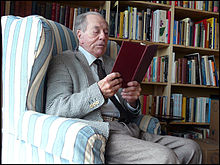- David Snellgrove
-
David Llewellyn Snellgrove Born June 29, 1920
Portsmouth, Hampshire, EnglandCitizenship United Kingdom Fields Tibetology Institutions School of Oriental and African Studies Known for Study of Tibet David Llewellyn Snellgrove (born 1920) is a British Tibetologist noted for his pioneering work on Buddhism in Tibet as well as his many travelogues.
Contents
Biography
Snellgrove was born in Portsmouth, Hampshire, and educated at Christ's Hospital near Horsham in West Sussex. He went on to study German and French at Southampton University. In 1941 he was called up to do his military service as a member of the Royal Engineers. He attended the Officers Cadet Training Unit in Scottish seaside town of Dunbar, and was commissioned as an infantry officer. Thereafter he attended various intelligence courses and further training at the War Office in London, from where he requested a posting to India.[1]
Snellgrove arrived in Bombay in June 1943, and travelled cross-country to Calcutta. He was stationed at Barrackpore, some way up the Hooghly River. A few months after beginning his posting he contracted malaria and was sent to the military hospital at Lebong, just north of Darjeeling. It was while he was at Lebong that he began his future life's calling by purchasing some books about Tibet by Charles Bell as well as a Tibetan Grammar and Reader.[2]
Snellgrove returned to Darjeeling, from where he sometimes went on leave to Kalimpong. On one of these visits he took a young Tibetan into his personal employ in order to have someone with whom to practice speaking Tibetan. He also travelled in the small Himalayan state of Sikkim, and on one such visit he met Sir Basil Gould, who was then the British Representative for Tibet.[2] Inspired to work in Tibet, in 1946 after he left the Army he sat the entrance exams for the Indian Civil Service. This was the first time the exams had been held since the start of the war, and the last time they were ever held. Although he passed the exams, he was not able to take up an appointment in India. Having already begun to study Tibetan, he resolved to find a university where he could further his studies. However, as no university offered courses in Tibetan at that time he was convinced by Sir Harold Bailey that a sound knowledge of Sanskrit and Pali would be beneficial, so he gained entry to Queens' College, Cambridge in October 1946. While at Cambridge, he converted to Roman Catholicism, in part through the influence of his friend Bede Griffiths.
In 1950, after having completed his studies at Cambridge, he was invited to teach a course in elementary Tibetan at the School of Oriental and African Studies University of London.[3] He was Professor of Tibetan at SOAS until his retirement in 1982.
Since his retirement Snellgrove's research has focused increasingly on the art history of South East Asia.
Bibliography
- 1957 Buddhist Himālaya : travels and studies in quest of the origins and nature of Tibetan religion. Oxford: B. Cassirer.
- 1961 Himalayan pilgrimage : a study of Tibetan religion by a traveller through Western Nepal. Oxford: Bruno Cassirer.
- 1967 Four Lamas of Dolpo. Oxford: Bruno Cassirer.
- 1967 The Nine Ways of Bon: excerpts from gZi-brjid. London: Oxford University Press.
- 1973 "Śākyamuni's Final "nirvāṇa." In Bulletin of the School of Oriental and African Studies, University of London, 36: 399-411.
- 1977 The cultural heritage of Ladakh. Warminster: Aris & Phillips.
- 1987 Indo-Tibetan Buddhism: Indian Buddhists and their Tibetan successors. London: Serindia.
- 2000 Asian commitment : travels and studies in the Indian sub-continent and South-East Asia. Bangkok: Orchid Press.
- 2001 Khmer civilization and Angkor. Bangkok: Orchid Press.
- 2004 Angkor, before and after : a cultural history of the Khmers. Bangkok: Orchid Press.
- 2006 Religion as History, Religion as Myth. Bangkok: Orchid Press.
With Hugh Richardson
- 1968 A Cultural History of Tibet. London: Weidenfeld & Nicolson.
References
- ^ "David Snellgrove interviewed by Sara Shneiderman and Mark Turin in Torre Pellice, Piedmont, Italy, on 20th September 2004". http://www.alanmacfarlane.com/DO/filmshow/snellgrove_fast.htm. Retrieved 27 April 2010.
- ^ a b Skorupski, Tadeusz (1990). Indo-Tibetan studies: Papers in Honour and Appreciation of Professor David L. Snellgrove's Contribution to Indo-Tibetan Studies. Tring: Institute of Buddhist Studies. pp. 2–3. ISBN 9780951542415.
- ^ "Tibetan Studies at SOAS". http://www.soas.ac.uk/cia/tibetanstudies/. Retrieved 27 April 2010.
External links
Categories:- Academics of the School of Oriental and African Studies
- Academics of the University of London
- Tibetologists
- Living people
- 1920 births
Wikimedia Foundation. 2010.

